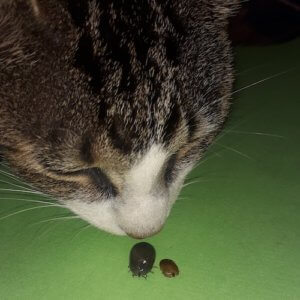Scratching, chewing, biting, licking, head shaking, scooting… it can drive any pet and owner insane. This constant itchiness is often what helps us recognise allergies in pets.
Allergies can also cause a myriad of other complications, including:
- inflamed ear canals
- secondary ear infections
- skin infections
- conjunctivitis
- coughing
- sneezing
- diarrhoea
- itchy skin around the anus and anal gland problems, causing a doggy to drag its bottom.

In this post, you’re going to find out what causes allergies in our furry friends, and what you can do about it.
Why does my dog or cat have an allergy?
Atopic dermatitis is the main cause of allergies in pets.
Atopic dermatitis is a genetic predisposition to developing multiple allergies throughout the pet’s life, and is affected by the immune system’s reaction to potential allergens upon exposure. In other words, the pet is not born allergic – instead, it starts off with a high likelihood of becoming allergic over time (called atopy). When it’s exposed to common environmental allergens like pollens, house dust, grass, etc, the body becomes over sensitised to these substances, and the immune system starts to react. In fact, it “over-reacts”, and this is usually harmful to the body.
Here’s how it works
Normal skin has multiple layers. The very outermost layer is made up of dead skin cells which are ready to be sloughed off. This acts as a barrier to protect the body from viruses, bacteria and other unwanted substances… including allergens. It has been found in dogs with atopy that this barrier function is disrupted. If you looked at it through a microscope, you would be able to see that the arrangement of these skin cells is irregular and interrupted, allowing allergens to penetrate.
Once allergens have penetrated the skin, they set off a chain reaction that ultimately triggers the immune system to release antibodies… even though the allergen is actually harmless. From then on, the allergens are imprinted on the immune system’s memory as known harmful agents. The immune system is now primed and ready to attack should it ever be subjected again to this perceived onslaught.
Upon a second exposure to the allergen, histamine is released and a cascade of inflammatory mediators (the messengers within the body that cause an inflammatory response) start wreaking havoc. Severe inflammation follows, with itching and redness. Your pet scratches, licks, bites and rubs, causing even more damage that opens the door for further infections.
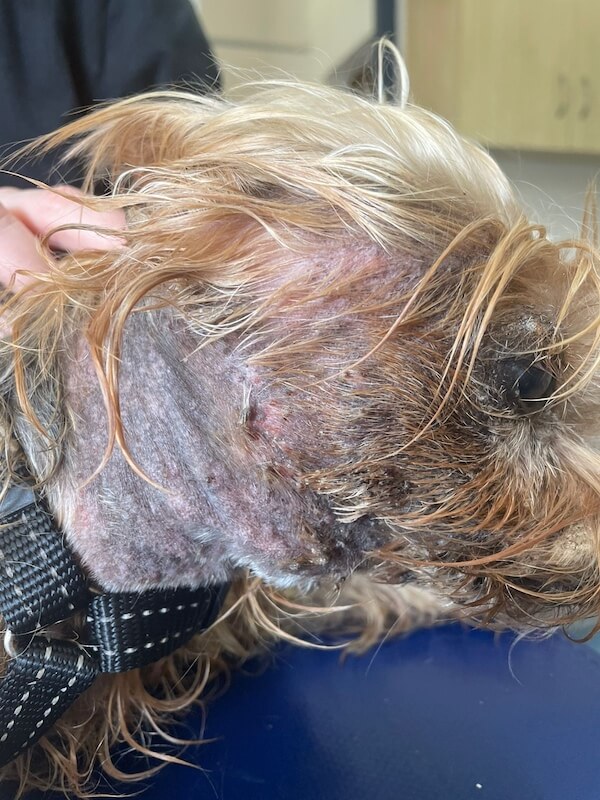
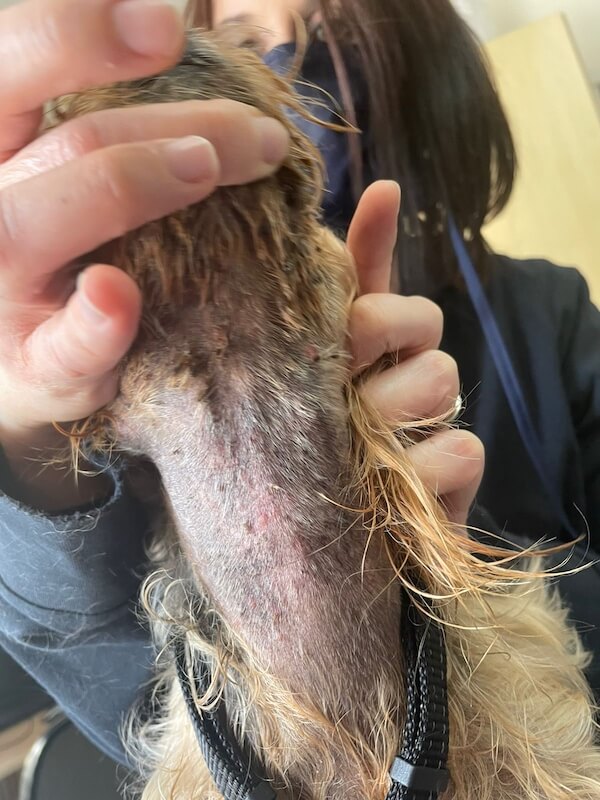
Severe scratching causes secondary skin infection, which in itself causes even more itchiness.
Science suggests it's a genetic issue
Atopic dermatitis is a lot more common in purebred dogs as opposed to cross breeds, with certain breeds having much higher incidence than others. This really underlines the fact that genetics are at the root of the issue.
One theory suggests that the faulty genetics causing atopic dermatitis has its origins in a multitude of minor DNA copy errors that have been accumulated over hundreds or even thousands of years of artificial selection, as opposed to natural selection where nature simply does not have the patience for such minor errors. People do not breed pets based on nature’s “survival of the fittest” model, but rather on our own models: survival of the fastest around the race track, or best sheep herding dog, or we simply breed them for looks, size, temperament, etc. By doing this we have come up with a wonderful array of different dog and cat breeds. The down side to this is that, from a pure health perspective, we have left them with a few design flaws that nature would never have allowed.
How to help a pet with allergies
When does it start?
Most pets are around 6 months to 2 years old when the first signs of an allergy start, but they can develop an allergy later on in life.
What can my pet be allergic to?
Allergens can be grouped in 3 main classes:
1) Indoor allergens. These include house dust and storage mites, flea saliva, or even cockroaches.
2) Outdoor allergens. There are multitudes of outdoor allergens – really ANY plant in your garden could be a cause of irritation to a pet’s immune system. Grasses, shrubs, flowers and trees with a high pollen count tend to be more allergenic.
3) Food. The most allergenic food stuffs are beef, gluten and dairy products… but really any protein or carbohydrate can cause an allergic or hypersensitivity reaction.
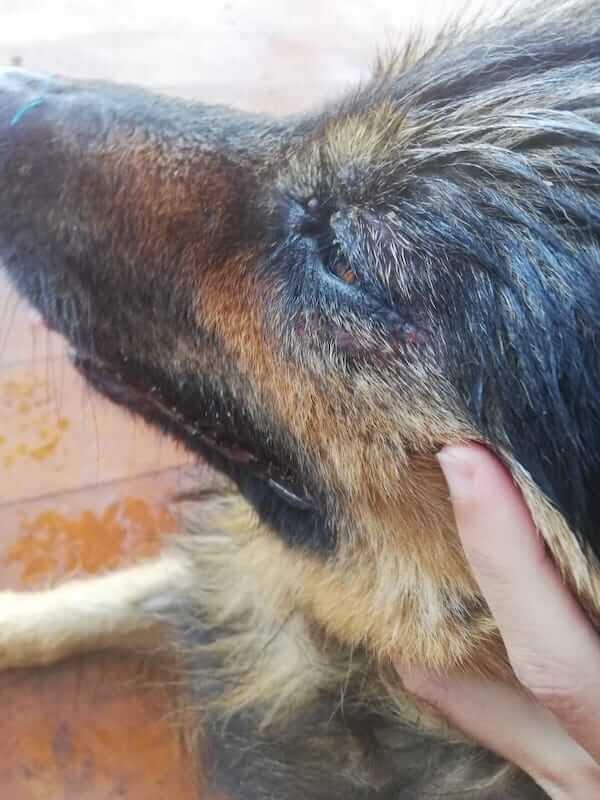
Severe facial itching around the eyes and mouth due to a food allergy.
Diagnosing allergens
There is a blood test available that can diagnose both indoor and outdoor allergens. However, when it comes to food allergies, the blood test is still unreliable and most vets will start a pet on a strict exclusion diet lasting for at least 6 to 8 weeks. The way that your pet reacts to this diet will help to determine which foods are causing problems.
Can I do anything to help my pet with allergies?
If food is suspected to be the trigger, sticking strictly to the diet plan your vet has created for you will ensure the best outcome. Even the tiniest morsel of allergic ingredient will cause the trial to fail.
Most allergic dogs, however, are also allergic to things out there that you can’t control. You can’t convince your neighbour down the road to chop down his flowering trees… and pull out his fynbos patch. Luckily, there are shampoos formulated to clear allergens and protect the skin’s natural barrier to help prevent a flare up, especially after a walk through incriminated allergens like grasses.
Do not wait until your pet’s allergy is out of control. Treating it promptly can avoid secondary bacterial and yeast infections which demand further treatments, like antibiotics and ear drops.
Prompt action is key.
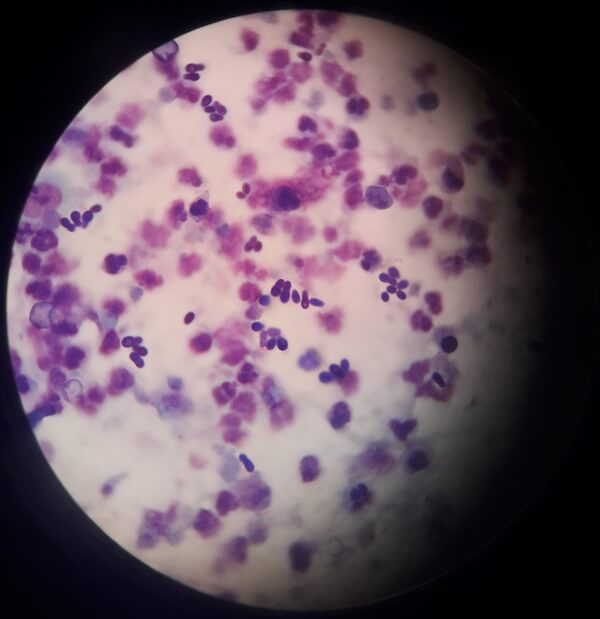
As seen under the microscope - Malesezzia yeast infection in ears secondary to an underlying allergy.
Treatment options
Unfortunately, an allergy is a lifelong condition – there is no known cure. Don’t despair, though; if you can’t avoid the allergens, it is still possible to manage the symptoms and vastly improve your pet’s quality of life. Treatment is long-term, or at least seasonal.
Here are your options.
1) Dietary
If your pet has a food allergy and we can find out exactly which foodstuff causes an allergic response, then we can control the clinical signs by completely avoiding these ingredients. Some dedicated owners will home-cook customised meals, although it might be tricky to get the right balance of nutrients, vitamins and minerals. Hypo-allergenic diets, or zero allergenic diets have been developed for allergic pets. These diets use either a novel protein source (like turkey, duck or venison), or a hydrolysed protein source, where the protein molecules have been chopped up so that the immune system does not recognise it. However, most pets suffer from allergies to other things as well, in which case diet alone won’t control their allergy.
2) Corticosteroids
Cortisones stop the inflammatory processes in a number of ways. It is also a general immunosuppressor, not only stopping the immune system from overreacting to innocent particles, but also from acting against real threats. This depression of the immune system may cause a pet to be unable to launch an attack on real threats like bacteria and viruses. It can cause many side effects. Excessive thirst and an increase in appetite are common. Because of its potent anti-inflammatory effect, it is still used extensively to control an allergic reaction. It is also a cheap option for allergy treatment.
3) Other immunosuppressant drugs
There are a number of alternative medications, for example cyclosporine and azothioprine, used to suppress the overactive immune system. They are often used together with cortisone (especially in immune-mediated disorders). They too will cause a pet to be generally immunodeficient, thus predisposing them to infections.
4) Antihistamine
Antihistamines have very limited use in treating pets’ allergies. They stabilise the mast cells and prevent further histamine release, but unfortunately they can’t undo the histamine and inflammatory cascade that has already started. It can be useful if the problem is caught very early, and it can to a limited extent prevent the allergic reaction from getting much worse.
5) Immunotherapy
This treatment involves testing for very specific allergens. An external lab will then formulate a customised “vaccine” against those allergens, and your pet will receive very tiny amounts of exactly what he is allergic to, and slowly increase the dose over time. It is also called allergen-specific desensitization.
6) Other oral medication
Newer allergy treatments include a drug called oclacitinib (Apoquel). This medication relieves allergic itch within 4 to 24 hours. It works brilliantly in most cases, but some pets might not respond adequately. It has much lower side effects compared to steroids and is currently one of our favourite drugs for treating atopy.
7) Monoclonal antibodies
This is a revolutionary breakthrough in atopy treatment for dogs. Lokivetmab (Cytopoint) works by binding to the body’s own allergy response triggers, rapidly reducing the allergic itch. It is a subcutaneous injection every 4 to 8 weeks, or as soon as the allergic itch starts again, and reduces the itch within 24 hours. Because it is a biological compound and not a chemical drug – these need to be broken down by the liver and kidneys – it hardly has any side effects and can be used in puppies and dogs with concurrent illness such as cancer.
Peace all round
Allergies are a debilitating, annoying and exhausting condition to both pets and their owners. With the knowledge we now have and the developing new therapies and options, we can give most pets a better quality of life by controlling those allergic itches and discomforts. Don’t ignore your pet’s chronic scratching – let us get to the bottom of the problem and deal with it, so we can all have a better night’s rest.




